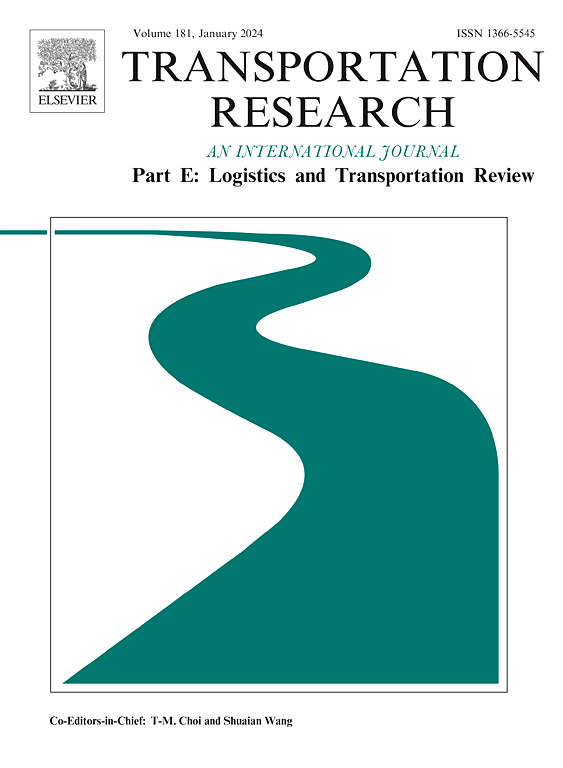Dynamic collaborative truck-drone delivery with en-route synchronization and random requests
IF 8.3
1区 工程技术
Q1 ECONOMICS
Transportation Research Part E-Logistics and Transportation Review
Pub Date : 2024-10-09
DOI:10.1016/j.tre.2024.103802
引用次数: 0
Abstract
Coordinated truck and drone delivery is gaining popularity in logistics as it can greatly reduce operation costs. However, existing studies on related operations management problems typically ignore the following important features: (i) the random appearance of requests, which require operators to dynamically respond to the requests; and (ii) the decisions of optimal launch and retrieval locations for trucks and drones instead of fixed to customer locations, which can significantly impact the overall time costs. To tackle these challenges, this study investigates the dynamic collaborative truck-drone routing problem with randomly arriving requests and synchronization on routes. We model the problem as a Markov Decision Process (MDP) and solve the MDP via a reinforcement learning (RL) approach. The proposed RL approach determines: (i) whether each request should be serviced upon arrival, (ii) which truck or drone should be assigned for the request, and (iii) the optimal en-route take-off and landing positions for paired trucks and drones. We further employ a framework of decentralized learning and centralized dispatching in RL to increase performance. Numerical experiments are conducted to assess the proposed solution approach on instances generated based on both the Solomon dataset and real-world operational data of a logistics operator in Singapore over several benchmark algorithms under various battery endurance levels of drones and distinct transportation scenarios including node-based dynamic collaborative truck-drone routing problem, dynamic non-collaborative truck and drone routing problem, and dynamic vehicle routing problem. The results show that our RL solution outperforms the benchmark algorithm in total profit by an average of 28.03 %, and our en-route takeoff and landing scenario outperforms the benchmark scenarios in total profit by an average of 8.43 % in multi-day instances. Additionally, compared to the traditional node-based landing scenario, employing our en-route takeoff and landing strategy can save 0.9 h/(drone*day) of waiting time on average.
具有途中同步和随机请求功能的卡车-无人机动态协作配送
协调卡车和无人机送货可以大大降低运营成本,因此在物流领域越来越受欢迎。然而,现有的相关运营管理问题研究通常忽略了以下重要特征:(i) 请求的随机出现,需要操作员动态响应请求;(ii) 决定卡车和无人机的最佳发射和回收地点,而不是固定在客户地点,这会极大地影响整体时间成本。为了应对这些挑战,本研究探讨了卡车与无人机的动态协作路由问题,该问题涉及随机到达的请求和路线同步。我们将该问题建模为马尔可夫决策过程(MDP),并通过强化学习(RL)方法解决该问题。所提出的 RL 方法可确定:(i) 每个请求是否应在到达时提供服务;(ii) 应为请求分配哪辆卡车或无人机;(iii) 配对卡车和无人机的最佳途中起飞和着陆位置。我们在 RL 中进一步采用了分散学习和集中调度的框架,以提高性能。在不同的无人机电池续航能力水平和不同的运输场景(包括基于节点的动态协作卡车-无人机路由问题、动态非协作卡车和无人机路由问题以及动态车辆路由问题)下,我们对基于所罗门数据集和新加坡一家物流运营商的实际运营数据生成的实例进行了数值实验,以评估所提出的解决方法。结果表明,我们的 RL 解决方案在总利润方面平均比基准算法高出 28.03%,在多天实例中,我们的途中起飞和着陆方案在总利润方面平均比基准方案高出 8.43%。此外,与传统的基于节点的着陆方案相比,采用我们的途中起飞和着陆策略平均可节省 0.9 小时/(无人机*天)的等待时间。
本文章由计算机程序翻译,如有差异,请以英文原文为准。
求助全文
约1分钟内获得全文
求助全文
来源期刊
CiteScore
16.20
自引率
16.00%
发文量
285
审稿时长
62 days
期刊介绍:
Transportation Research Part E: Logistics and Transportation Review is a reputable journal that publishes high-quality articles covering a wide range of topics in the field of logistics and transportation research. The journal welcomes submissions on various subjects, including transport economics, transport infrastructure and investment appraisal, evaluation of public policies related to transportation, empirical and analytical studies of logistics management practices and performance, logistics and operations models, and logistics and supply chain management.
Part E aims to provide informative and well-researched articles that contribute to the understanding and advancement of the field. The content of the journal is complementary to other prestigious journals in transportation research, such as Transportation Research Part A: Policy and Practice, Part B: Methodological, Part C: Emerging Technologies, Part D: Transport and Environment, and Part F: Traffic Psychology and Behaviour. Together, these journals form a comprehensive and cohesive reference for current research in transportation science.

 求助内容:
求助内容: 应助结果提醒方式:
应助结果提醒方式:


